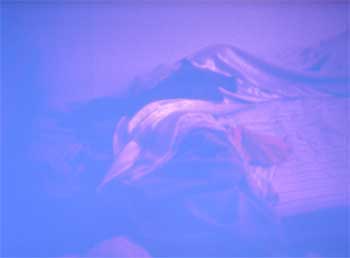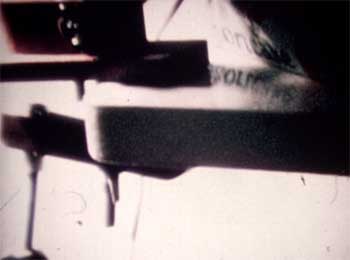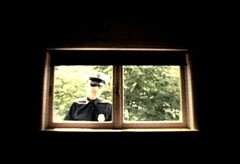From The Soho News (January 14, 1981). — J.R.
“When I came to New York in September,” English avant-garde filmmaker and film theorist Peter Gidal tells me, “I noticed that almost every film review that I read used food metaphors and digestion metaphors to talk about art and cinema. Because consumption, digestion and predigestion is the dominant mode in this country. It’s just one signifier of the attempt to break with materialism and process, and to anthropomorphize everything.”
An “English” label should be assigned to Gidal only after some qualification. Born in 1946, he grew up in Mount Vernon, N. Y., and Switzerland and attended Brandeis University before settling in London in the late 60s. Although his accent sounds more redolent of Manhattan than of London, he has spent only two of the past 21 years in the U.S.
Regarding his opposition to food metaphors (as well as narrative), he recalls a drinking cup that he used as a kid for drinking milk. “It had a house on the outside, and on the inside, as you gradually drank, you could see the words, ‘The End.'”
“Which ties up with the idea of closure,” I suggest pedantically, referring to a discussion we’ve been having about Action at a Distance, his latest film.
“And American milk,” Peter says. “Which tastes wonderful.”
***
As a rule I find myself spending a lot more time thinking about Gidal’s anti-narrative, anti-illusion theory of film than I do either looking at or thinking about his “structuralist/materialist” films. Like many other locals who might have been interested, I missed a screening of Action at a Distance at Millennium in late October because of the Kitchen’s concurrent TV symposium (although I did get to a show of older Gidal films at the Collective two weeks earlier).

So when Peter — a friend since the mid-70s — came out to my Hoboken flat for this interview, he brought along a print of Action at a Distance for me to see. I’m glad I saw it, but I can’t say it furnishes more to me than diagrams enacting reduced models that are produced by his theory. This theory, however, is something that I find productive and useful — particularly as a dialectical critique of the cinema that I usually make my living writing about.
![]()

Action at a Distance features a somewhat abstract text, written by one woman and read by another, over hand-held shots of diverse fragments of domestic spaces, for approximately half an hour. It doesn’t commit any of the crimes that Gidal argues most films commit. It doesn’t even seek to be beautiful — only lucid and correct. (“I’m quite happy to admit that I am not interested in Snow’s work for ‘the beauty,'” he wrote almost a decade ago in a polemical exchange with structural filmmaker Michael Snow about Snow’s Back and Forth, included in Gidal’s Structural Film Anthology.)
“To annihilate beauty is not some kind of metaphysical statement that beauty shouldn’t exist in the world,” Gidal explains to me. “Even to mention that would be an impossible negation, because beauty exists in the same way that representation exists. But it exists in certain codes and manifestations and positions for certain people as their positions. So to say I’m not concerned with beauty — that’s because (A) from a puritanical point of view it’s very easy to create beauty. (B) If you have a traditionally high-art education, and if you come out of a kind of history — out of painting, sculpture, theater, movies and all that — then as far as I’m concerned, it’s the least interesting, least productive aspect of a practice, to create something someone else might say is beautiful.
“The worst part is, it’s meaningless in the bad sense. It’s the seductive element, which is separate from everything else which work is doing. It’s the element which represses, in fact, the operations that exist between you and a film, or a film’s operation on and through you as a viewer, or the imaginary inhabitant of a space in a film or a narrative. Whatever it is, it’s the beauty which seduces and represses at the same time.
“So it’s the politically reactionary element in beauty I was referring to,” Gidal concludes, adding, “A lot of good work is beautiful.”
***
“Would it be correct, then, to call you a minimalist?” I’m thinking now not only of Gidal’s 1971 book, Andy Warhol — the first book on Warhol in any language — but also his projected study of monologue and gesture in the work of Samuel Beckett, the other living artist he respects most, which Macmillan in England plans to publish.
“I’m a purist in the sense that the work has to do with very few elements. Very little is dealt with, I don’t have a broad range at all. I went through the whole 60s without going to double-screen, triple-screen, stereo — none of that stuff. I have enough problems dealing with single-screen. A very minimal area of concern — if that’s what you mean, yeah, hopefully they’re rigorous and rigid almost, in a very small area.”

“What action are you thinking about in the title of your film?”
“Well, action at a distance has something to do with the film’s being at a distance, as opposed to within — you are not within them. And action is a good word. It poses a real Leninist notion of contradiction. Not just multiple interpretation or ambiguity — which is the dominant art-journal/art-history way of seeing it, certainly in New York — but real contradiction where opposites literally come out of a same point. And these opposites then have to be worked through and processed, and then an ideological, political position is usually taken, to go on from there.
“It’s not like a unity of opposites, but both are there and then it’s politics that motor one position over the other, as opposed to that silly notion of the happy synthesis. `Action’ therefore has a lot of meanings, from `action in the street’ (slang) — of which there isn’t any in the film — and action in the sense of act, narrative, something happening….
“In general it’s a context for a kind of film which is meant to deal with questions of internal action, action of the viewer, the subject of the viewer and how he or she is placed or not able to be placed, ot only illusionistically placed within the film, the sound-image relation….
“I hate to say this, but Gertrude Stein and Ludwig Wittgenstein are both important — yet the latter can hardly be mentioned because in New York everyone mentions him, none of whom seems to have read him. But there’s a Steinian and Wittgensteinian and Beckettian importance to that kind of work on language and signification and that inability of the hold on the real by language. One practice doesn’t cover another. A film is not about the world.”
***
Maybe not. If that’s the case, then Gidal has to his credit two dozen films since 1966 about themselves, all on deposit at the London Filmmakers’ Co-op. (Four are in te New York Co-op.) A partial history of this co-op is given by Gidal, one of its founders, in his essay in The Cinematic Apparatus, a collection recently published over here by St. Martin’s Press. The most useful of these films that I’ve seen is Room Film 1973 — made the same year he started to teach graduate students at the Royal College of Art — which intermittently allows the viewer a certain hypnotic engagement, which is then interrupted.
![]()


At one point Peter reads me an entry from Brecht’s notebooks in 1920: “One has one’s own laundry and one washes it. One doesn’t have one’s own words, and one doesn’t wash them. In the beginning was not the word — the word is at the end.” For a theorist as difficult as Gidal, it’s nice that he can often refer to material things, in interviews as well as films — at least using laundry metaphors if not ones connected to the idea of consumption.
“Everything is the effect of a productive labor process,” he says, “even every cultural moment. And if the film and the process of the film are produced in a materialist as opposed to an idealist manner — both in the way it situates the viewer and in its own textual operation, in the crude material sense the way it’s structured — then you can produce everything as effect, even emptying-out, the fact that nothing adheres.”


